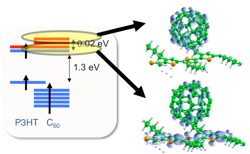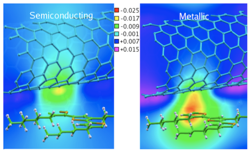Charge Separation at the Heterojunction Interface


For example, in one project, our goal has been to understand charge separation at the best-performing polymer-based solar cell (C60/P3HT blend): namely, why is it so efficient? What we learned is that there is a more subtle picture of the charge separation mechanism than has been generally assumed. Specifically, the separation occurs in a two-step process as shown in this figure: (bottom) hybridization of P3HT pi* state and C60 t1u state, distributed evenly across the junction; (top) charge separated state which is essentially degenerate with bridge state.

In another related project, our interest has been in elucidating the role of semiconducting vs. metallic carbon nanotube solar cells. In particular, we have studied the same interfacial electronic structure as for C60, here with the intent of understanding why CNT/polymer solar cells work quite poorly compared to the C60 blends. Our calculations show that for a semiconducting CNT, a Type II heterojunction forms and efficient charge separation can occur; however, for metallic nanotubes a large charge transfer takes place with the polymer and we observe no Fermi-level pinning. These results indicate that charge separation is unlikely for metallic tubes and therefore that CNT/polymer solar cells are unlikely to work well with a mixed distribution of metallic and semiconducting tubes.
For more information about this work, see Y. Kanai and J. C. Grossman, “Insights on interfacial charge transfer across P3HT/fullerene photovoltaic heterojunction from ab initio calculations,” NanoLetters 7, 1967 (2007). And, Y. Kanai and J. C. Grossman, “Role of Semiconducting and Metallic Tubes in P3HT/Carbon-Nanotube Photovoltaic Heterojunctions: Density Functional Theory Calculations,” NanoLetters 8, 911 (2008).
Hybrid Materials for

Home / Research / Energy Conversion / Solar Cells / Polymers


Organic, polymer-based solar cells—lightweight alternatives to conventional, silicon-based solar cells—have great potential for delivering inexpensive solar energy and lowering manufacturing costs, while maintaining high power efficiency. However, the highest efficiency achieved so far with polymer-based solar cells is only 5 to 6%, far too low to be effective in many practical applications. Furthermore, degradation from UV radiation and other means causes organic solar cells to have extremely short lifetimes compared to traditional photovoltaics based on silicon.
In this work we aim to address two of the major bottlenecks in organic solar cells – degradation and efficiency – by applying and developing a range of accurate simulation techniques, tightly coupled with experimental synthesis and characterization. We begin by predicting some of the key fundamental properties and processes that are most relevant to these two critical limitations in organic solar cells

Solar Cells
Massachusetts Institute of Technology, 77 Massachusetts Avenue, Cambridge MA 02139-4307

